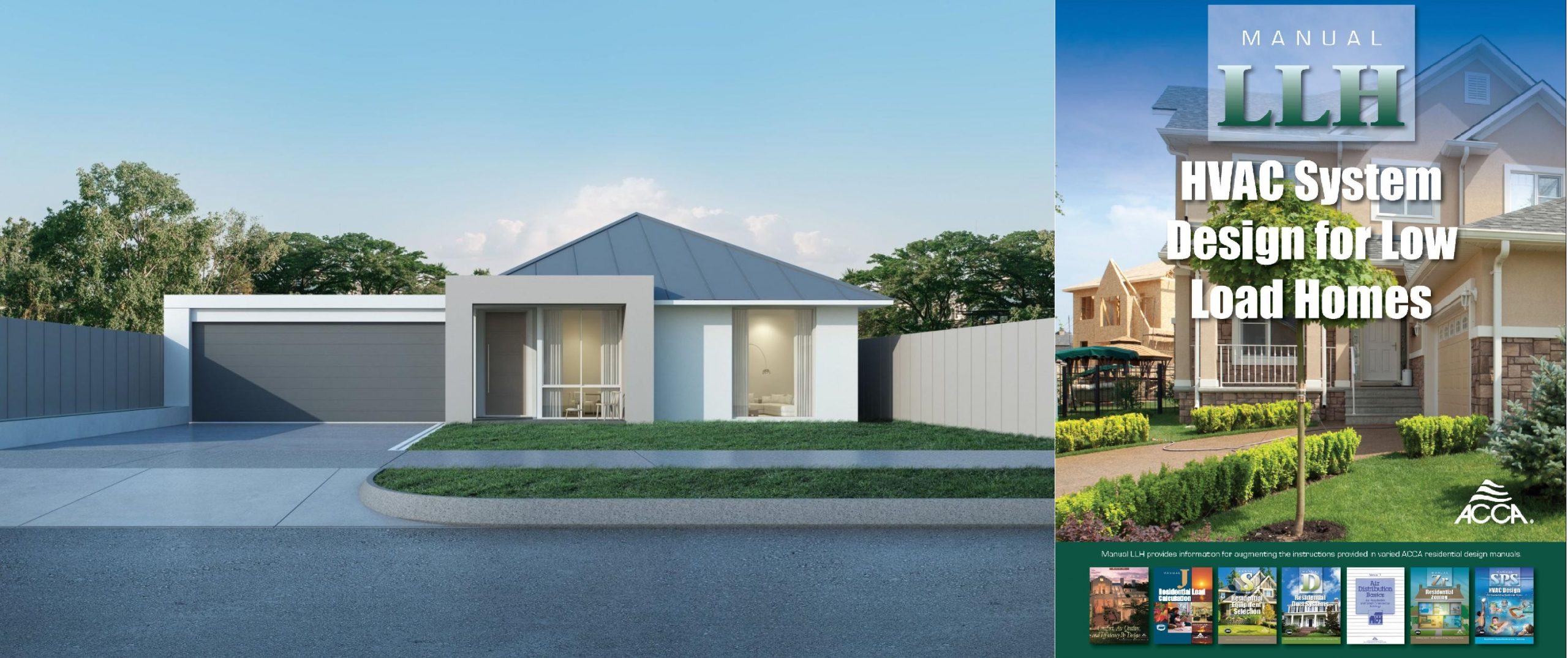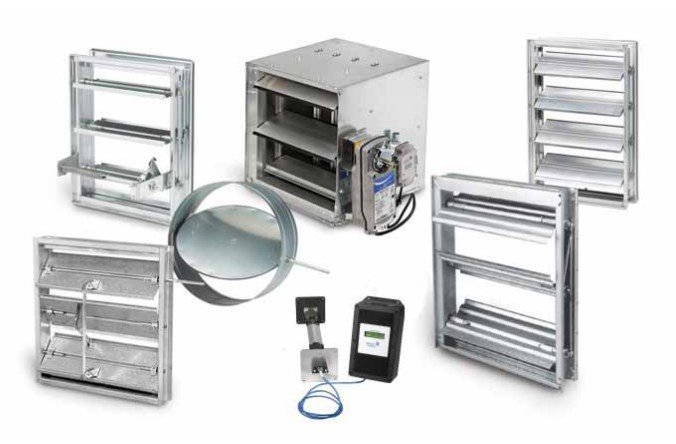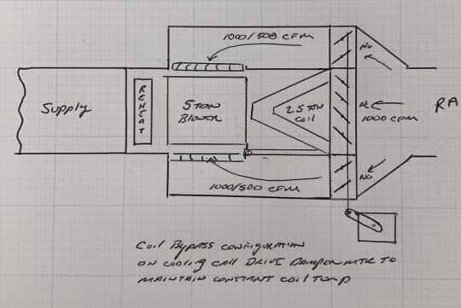Get Tech Tips
Subscribe to free tech tips.
Bypass Dehumidification/Airflow HVAC Design
There have been several past posts on our Facebook group page about a concept called bypass dehumidification. I think technicians could benefit from learning more about this topic.
Bypass dehumidification or airflow is an interesting method for utilizing mixed air temperatures to maximize a system’s dehumidification capabilities. It's also a means of supplying adequate air exchange rates to large-volume buildings.
Case study: Harry Boody’s design
The design blueprint featured below was created by Harry Boody of Energy Innovations.

(To avoid confusion, the blueprints here show the return side in blue and the supply side in red.)
Harry Boody’s design uses a 2-stage system that is almost always locked out on Stage 1 but with the blower motor set on high speed. In order to achieve this function, the system is decoupled from the blower demand controls. The control wiring requires a little extra thought, but the goal is to allow the blower motor to operate independently of the system. There are four dampers in this duct system to allow for airflow balancing across the coil.
As seen in the diagram, the top bypass duct has a fixed volume damper and a power close motorized damper. Below this larger bypass is a smaller bypass duct with a fixed volume damper and another power close motorized damper. Before I move on to the technical aspects of the design, let me explain why we use this design in the first place.
The challenges of low-load buildings
Low-load buildings with large volumes introduce a unique issue when it comes to comfort and indoor air quality. The heat loads are low, which is good when it comes to equipment sizing; smaller equipment is cheaper. However, the volume of the building remains the same, which means a smaller HVAC system that has a limit to its airflow delivery capabilities cannot meet adequate air exchanges per hour within the home. The ASHRAE Guidebook has published recommended air exchange rates for various applications. The most common exchange rate for residential homes is 4-5 air changes per hour.
Air exchange rates
When I say “air exchange rates,” I’m not talking about ventilation rates. I’m referring to the number of times the air is exchanged between the building envelope and the HVAC air distribution system. Removal of particulate matter is another reason why a rate of 4-5 exchanges per hour is ideal. The more passes through a high-quality filter media (MERV 13+), the more particulate comes out of the air. Also, because the air exchange rate prevents stratification, particles can’t settle on surfaces.

For example, Let’s take a 3500 ft2 home with an average ceiling height of 9 ft. The total volume of the home is:
2500 x 9 = 31,500 ft3
For this example, let’s use 5 air exchange rates per hour.
31,500 x 5 = 157,500 cubic feet per hour (CFH)
157,500 ÷ 60 minutes per hour = 2,625 cubic feet per minute (CFM)
The design airflow for this home is 2,625 CFM. But this is a fairly tight, well insulated, modern home, and the total heat load on the building calls for around 36,000 BTUs. We know that the best we can do with a standard piece of equipment is 1,350 total system CFM (at 450 CFM per ton). That's still 1,275 CFM shy of the needed airflow. Also, we wouldn’t necessarily want to increase the airflow across the cooling coil; doing so would reduce the latent capacity of the system. In fact, in hot and humid climates, most contractors set the airflow through the coil to 350 CFM per ton, which would only give us 1,050 total CFM in this case.
There really is no way to rectify this problem with pre-manufactured equipment. That's because systems are designed to allow a certain amount of airflow to pass through the coil for maximum efficiency. A designed solution is required, and that’s what bypass dehumidification or airflow sets out to do.
I know I said I would go through the technical aspects of the design Harry Boody uses in the image at the top of this article, but I actually don’t think it would help much here. The truth is, Mr. Boody over-engineers his designs (excess ductwork, proprietary control boards, wifi-connected damper motors, etc). However, his concept for bypass dehumidification and maximized air exchange rates is worth exploring.
So, in keeping with the example I’ve already established with the low load home requiring 2,625 CFM, let’s explore how we might design a solution to solve the load/airflow discrepancy.
Solving the discrepancy between load and airflow
The concept is simple: select a blower and duct system that will deliver the design CFM to the building 24/7 and only deliver the manufacturer’s rated airflow to the coil/heat exchanger.
Basically, you are creating two designs: airflow and heat load. Once the calculations have been made for the needs of the building envelope, the duct design attached to the HVAC system is fine-tuned with dampers (and possibly control boards) to deliver only the design airflow for the system.
The excess airflow is bypassed around the coil. The bypassed air (room temperature) will mix with the supply air off the cooling coil and be reheated before being distributed through the duct system. The term “reheat” should sound familiar if you’ve ever used electric reheat dehumidification. However, in this design, the air is able to be reheated without the use of extra resistance heat energy. It’s being reheated just by getting mixed with room temperature air. That’s much more efficient!
The biggest obstacle to overcome with this design is air balancing. It’s a matter of selecting the right dampers and setting them properly.
 You may be wondering how I’m going to get a larger blower into a smaller air handler. I could select a 2-stage piece of equipment, but I’m going to show an alternative in this example.
You may be wondering how I’m going to get a larger blower into a smaller air handler. I could select a 2-stage piece of equipment, but I’m going to show an alternative in this example.
Equipment selection
Let’s select a cased coil for this design and a blower unit that is a separate component to the system. Only the designed amount of airflow will pass through the indoor coil by way of a calibrated motorized damper. The rest of the airflow bypasses around the cased coil and dumps back into the volume of the blower box. So, in the testing and balancing of a system designed with oversized blowers and bypass ducts, we must take care to calibrate how much the coil damper opens in both cooling and heating (if this were a heat pump).
I would suggest selecting two 1.5-ton split systems for this example. I would go this route for two main reasons.
On one hand, I can get closer to the designed air exchange rates by using two blower motors, instead of one 5-ton blower (which would get us to only around 2,250 CFM). Being slightly under 2,625 CFM would be perfectly fine because we would be between 4-5 air exchanges per hour at that point.
However, the second reason why I would opt for two systems is redundancy. If one system goes down for any reason, the customer still has at least one system, and the risk of stagnant air is still low. Also, higher-MERV filters are better than less! ALSO, using two larger blower motors gets me closer to my 5 air exchange rates per hour.
Before moving on, it’s important to note that you don’t have to select two separate systems. Many applications (for example, smaller homes) could simply use a 2-stage system that uses 1st-stage capacity and is decoupled from blower demand controls so that the blower runs at high speed 24/7.
There are more ways than one to find a solution to the low load/high volume problem. The focus of this article is specifically the bypass aspect of the design.
Air balancing
Now, after you've sized your ductwork, selected your equipment (depending on how de-rated your appliance will be, you might end up with two 2-ton split systems), and laid everything out, the air balancing must commence.
For this example, the system needs around 350 CFM per ton through the cooling coil. Below is a sketch of a very simplified version of this bypass design by Jim Bergmann.

The first thing to do here is to calibrate the weighted dampers to be fully open with the coil damper closed (once the system cycles off) but to close down enough once the motorized damper for the coil opens up. I haven’t tested this yet, but I find myself questioning whether the bypass ducts actually need dampers at all. Once the motorized damper for the coil opens up, the air might still pull through with or without the dampers on the bypass duct.
So, could we get away without using bypass dampers?
Possibly. Design guru Michael Housh suggests we could get away without the bypass dampers if the bypass ducts were aggressively small. The following is a quote from Michael’s notes about the idea:
“If you want to be able to do more sensible work at times, then the by-passes should have dampers. If you are okay with always by-passing (meaning that the sensible temperature coming out of the register is not of concern), then no dampers may work (of course more testing would be required).
I think that without at least manual dampers, you may have trouble because the air is WAY more likely to take the by-pass route than through the coil.”
I think this is a great example of a concept I talk about a lot: There is no one-stop-shop answer to anything in our trade. Designed solutions require thought and care into the context of a particular building and its occupants.
An important aspect of this design is to make sure the blower stays on 24/7 in order to keep the air exchange rates consistent. The ducts should be pretty oversized. Lower the velocity inside the ducts, and just make sure your supply grille selection game is strong. The blower motor doesn’t actually pull much power, so keeping it on all the time isn’t that big a deal, especially when it isn’t working against high static pressure in the ductwork. Making sure that there is a high MERV filter at every return duct before the blower/coil is very important for air purification.
Where do you see this design being beneficial? What are the biggest concerns you might have about this design? A big issue I run into with discussing this design with technicians is warranty issues. I am fully aware of the issues with manufacturers voiding the warranty when some people alter the equipment this way. I’d rather stay away from that particular discussion point. It exists, it’s a concern, but that’s a problem outside the design aspect.
What would you like to see in the concept of this design that might interest you more?
—Kaleb Saleeby











Comments
Hey Kaleb,
Thanks for this article! My first thought is that with the bypass air heat also comes the bypass moisture. As 72 degree / 55% rh air mixes with 55 degree 100%rh don’t we risk creating a cloud inside the blower? Ive had nightmares of Rick sims video of air bypassing the coil in an AH creating a cloud. And if you are pulling in any fresh air from outside Zoinks!! Of course I may be misunderstanding. Thanks again!
Hey Kaleb,
Thanks for this article! My first thought is that with the bypass air heat also comes the bypass moisture. As 72 degree / 55% rh air mixes with 55 degree 100%rh don’t we risk creating a cloud inside the blower? Ive had nightmares of Rick sims video of air bypassing the coil in an AH creating a cloud. And if you are pulling in any fresh air from outside Zoinks!! Of course I may be misunderstanding. Thanks again!
[…] HVAC design circles, a concept called “bypass dehumidification” is gaining traction. HVAC School produced a very informative tech tip about this in March 2022. There, it describes bypass dehumidification benefits as […]
[…] HVAC design circles, a concept called “bypass dehumidification” is gaining traction. HVAC School produced a very informative tech tip about this in March 2022. There, it describes bypass dehumidification benefits as […]
All this discussion hinges on the assumption of The ASHRAE Guidebook published recommended air exchange rate for homes at 4 to 5 ACH. I have searched high and low and can find NO mention of this concept in any ASHRAE publication. Can someone provide a cite to verify this claim?
All this discussion hinges on the assumption of The ASHRAE Guidebook published recommended air exchange rate for homes at 4 to 5 ACH. I have searched high and low and can find NO mention of this concept in any ASHRAE publication. Can someone provide a cite to verify this claim?
To leave a comment, you need to log in.
Log In